As urbanization and climate change are impacting aquifers across the country, officials and municipalities are turning to new technologies to meet water demands.
For many entities, investing in Aquifer Storage and Recovery (ASR) systems might be the way to go.
ASR, which was first tested and experimented in the 1990s, calls for the pumping of groundwater during periods of heavy supply and storing it in another aquifer for use in times of drought or major drawdown.
“What this climate report doesn’t give us, and what we would love, is a way to quantify what we can expect in the future. What we’ve been hearing for some time is the idea that the droughts and floods will be worse than what we’ve seen.”
–Brian Smith, BSEACD principal hydrologist
Kerrville and San Antonio were the first two major cities in the state to implement ASR.
These efforts are in conjunction with the fourth National Climate Assessment (NCA), a national report from the federal government, which shows climate change will have an increasing effect on drought and flooding in Central Texas.
In Hays County, scientists at the Barton Springs Edwards Aquifer Conservation District (BSEACD) are looking at ASR as a potential means to alleviate pressure on the aquifer during times of drought.
The Ruby Ranch subdivision near Buda is the first testing site for ASR in Hays County. In this location, water is pumped from the Edwards Aquifer and transferred to the Trinity Aquifer. In 2018, city of Buda officials pushed forward with plans to build a pilot well for an ASR system.
Water experts hope the project will curb the effects of moderate drought in the future.
“What this climate report doesn’t give us, and what we would love, is a way to quantify what we can expect in the future,” said Brian Smith, BSEACD principal hydrologist. “What we’ve been hearing for some time is the idea that the droughts and floods will be worse than what we’ve seen.”
While some experts point to a lack of quantitative data in climate reports, research indicates that aquifers across the country are in trouble, including the Edward’s Aquifer, which supplies water to many Central Texans.
According to the NCA, long-term droughts have led to a significant depletion of aquifers in many regions of the country. Aquifer decline accelerated from 2001 to 2008 due to “persistent droughts in many regions,” as well as the lack of adequate surface water to meet demand.
“This decline in groundwater compromises the ability to meet water needs during future droughts and impacts the functioning of groundwater dependent ecosystems,” according to the report.
Although experts say ASR is not the only long-term solution to solve water woes, the consensus is that it will help.
Kevin Kluge, Texas water development board director of conservation and innovative water technologies, said the geology and quality of groundwater must meet certain standards for the technology to be effective.
An imbalance in the chemistry of soil and water can cause the creation of compounds that may be detrimental to the health of the water.
“The Edwards Aquifer has more dynamic rises and falls depending on the conditions of the climate, which makes it an aquifer where this technology can work, as we’ve seen in Kerrville and San Antonio,” Kluge said. “It’s an important tool in the box and a way to store water for when it's needed, especially during multiyear droughts.”
Kluge said Texas’ 2017 state water plan mentions around 20 recommended ASR projects.
In San Antonio, the Twin Oaks ASR system, which has been in operation since 2003, pulls groundwater from the Edwards Aquifer and then transfers it to Carrizo-Wilcox Aquifer.
San Antonio’s efforts have been deemed a success by water experts, paving the groundwork for other municipalities to follow suit. Kerrville’s system is also deemed a success, as it was the first operational ASR project in 1992.
“Despite climate change, we need to focus on what we can do during times of drought,” Smith said. “We have a set of conditions set for pumping during the equivalent of the drought of record, so the board can vote to limit groundwater pumping when need be. We are not climate change experts, but there are efforts that the groundwater district can deploy in addition to these new advancements in conservation efforts.”











